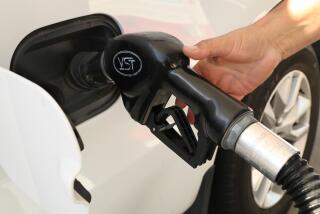Suit Over Smog Rules Settled
Southern California’s regional smog-fighting agency has agreed to settle a lawsuit by two environmental groups alleging that the agency has mismanaged one of its biggest anti-pollution programs, allowing power plants and refineries to emit more unhealthful exhaust than allowed by federal laws.
The suit accused the South Coast Air Quality Management District of violating the Clean Air Act by improperly overseeing a landmark program that had allowed about 350 companies to buy and sell pollution credits while capping the overall amount of permitted pollution. As a result, the air district, which is charged with reducing air pollution in Los Angeles, Orange, Riverside and San Bernardino counties, had allowed nearly a million excess pounds of smog-forming gases to enter the atmosphere, according to the lawsuit.
Under the settlement with Communities for a Better Environment and Our Children’s Earth, the district agreed to tighten enforcement against companies that exceed emission limits and to make more program data available to the public on the Internet. It also agreed to create a $1-million fund to reduce air pollution in low-income communities.
Environmentalists have long criticized the cap-and-trade program, contending that even when it reduces overall pollution, it allows worse pollution from some facilities, which disproportionately affects poor neighborhoods.
“This provides the public with more certainty over how the air district will police the program in the future,” said Scott Kuhn, legal director of Communities for a Better Environment. “In our view, they were not policing the polluters enough. They were letting these companies off easy, even when they did catch them breaking the law.”
The cap-and-trade program, known as “Reclaim” (for Regional Clean Air Incentives Market), is supposed to give companies a financial incentive to reduce air pollution. It regulates the emission of nitrogen oxides, which leads to the creation of ozone, the principal element of smog.
Companies that reduce emissions faster than required earn extra pollution credits, which they can bank for the future or sell on the open market to companies that are exceeding their allotments. Companies that go over their limits receive fewer credits in the future.
However, the air district had been allowing companies that were exceeding the limit to delay the purchase of credits for years into the future, Kuhn said.
“It is a market-based system. It works on supply and demand, and if you go over the cap, you should have to buy credits right there, not in five or six years,” Kuhn said. “It became a game where [businesses] were waiting, speculating on the prices of credits going down.”
Air district officials conceded they had been interpreting the program rules incorrectly. They said many of the violations had occurred during the energy crisis, when power plants were running at full bore, and that some companies had polluted so heavily that taking away all of their credits would not have been a severe enough penalty. Environmentalists argued that such companies should start the year with a deficit and should be forced to buy more credits.
“We have agreed that is the more appropriate way to interpret this rule,” said the air district’s chief attorney, Barbara Baird.
More to Read
Sign up for Essential California
The most important California stories and recommendations in your inbox every morning.
You may occasionally receive promotional content from the Los Angeles Times.










